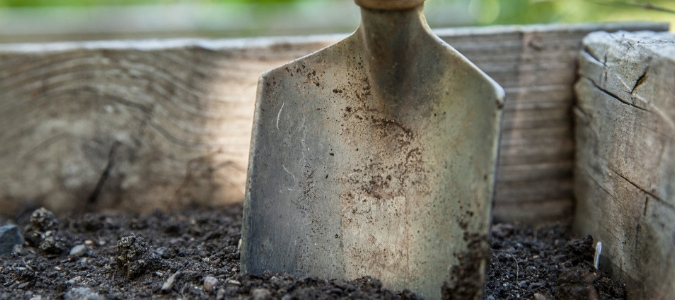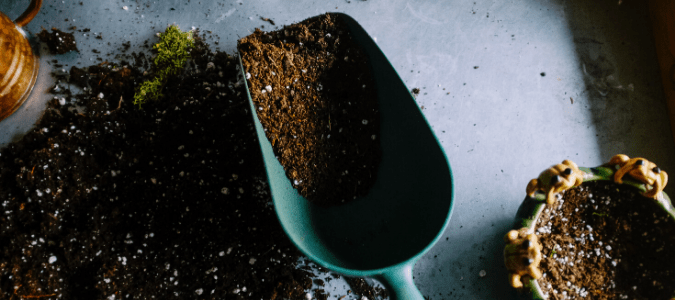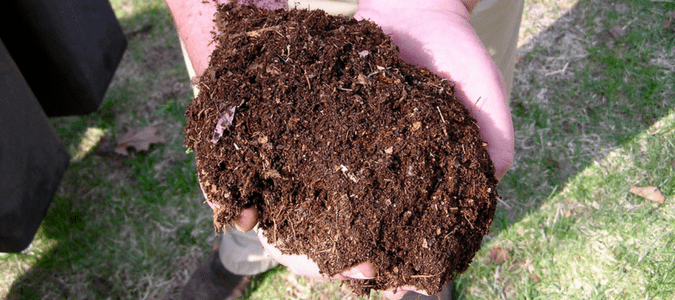Using compost is a great way to build a solid foundation if you are trying to establish a new lawn or to revitalize an existing yard or garden. The exact amount of compost you will need for your project depends on how you plan to use it. However, in general, if you are mixing compost into soil, then compost should make up no more than 25% to 30% of your mixture.
A basic formula to figure out how much compost you will need to make or buy is to first find the area of your yard by multiplying the length of your space by its width in feet. Next, use the guidance below to find out how deep the compost should be (in inches). Divide the depth by 12 and then multiply this number by the area of your yard. This will give you an estimate of how many one-cubic-foot bags of compost you will need.
To determine the depth of compost you need, consider what you are using it for. Some general places that you might use compost and the depths you would need include:
- A new lawn. If you are trying to establish a new lawn, especially in an area with clay or sand, then you can mix about one to two inches of compost into the top six to eight inches of your soil to help make it richer.
- An existing lawn. If your lawn is already established, you will need to apply about a quarter-inch to half-inch of compost on top of your grass or soil. With existing lawns, you usually only need to apply to top dress once or twice each year, typically in the spring and fall.
- A flower bed. Compost can also be a great addition to your garden or flower bed. To apply compost in a raised bed, blend around one to three inches of compost in the top six to eight inches of soil. Do this once a year in the spring.
For most other areas, it is typically good to use a ratio of no more than about 25% compost to about 75% soil. For example, in areas around shrubs or trees, you can dig a hole that is as deep as the ball of the roots and around two or three times as wide as this depth. Take about 75% of the soil you have removed and combine it with enough compost so that compost makes up about 25% of the mixture. Then, put this mixture back into the hole. You can use a similar method for planting with compost.
Once your plants are established, you can also use compost to mulch around the plants. You can do this a couple times a year to help protect their roots and retain moisture.
It can be confusing to try to figure out how much compost to add and when to use it. That is why it is typically best to contact a professional who is knowledgeable on all aspects of lawn care. They have the specialized knowledge, experience and tools to make sure your lawn gets all the benefits from compost without you having to worry about whether you are doing it right.
Benefits of Composting
When done correctly, making compost and adding it to your yard has many different benefits, such as:
- improving the structure and aeration of your soil;
- decreasing the amount of waste your household sends to landfills;
- encouraging the growth of beneficial microorganisms;
- saving money on your water bills by helping soil absorb and retain moisture;
- decreasing the chance of water contamination from fertilizer runoff;
- assisting with drainage and stormwater control;
- producing nutrients that help plants grow healthy;
- saving your household money by reducing your need to buy manufactured fertilizers and
- helping protect your plants from harmful diseases and against extreme temperatures.
Compost Versus Fertilizer: What One Should I Use?
It can be hard to know what is the best product to use when you are tackling a household project like planting a new area of your yard or keeping an existing garden healthy.
Two options you might consider to help with these projects are compost and fertilizer. Both provide plants with beneficial nutrients and can be used in a variety of ways. For example, homeowners can use these substances as a supplement to soil when establishing a new lawn or garden or as a way to help revitalize an existing garden or lawn.
While compost and fertilizer have some similarities, it is important to also consider the differences between them when you are trying to decide which one is the best choice for your yard. For one, compost is produced through a natural process involving organic sources, such as yard trimmings and kitchen waste. Compost is made by combining these organic materials with water and oxygen in a special composting bin. Over time, the waste “bakes” and decomposes, producing the nutrient-rich material called “compost.” On the other hand, fertilizers are manufactured in a commercial or synthetic process using minerals like ammonium sulfate.
Another thing to consider is the nutrient content of each substance. For example, fertilizers typically provide a more predictable mix of nutrients than compost. When you buy fertilizer, the packaging will typically list the precise amounts of phosphorus, nitrogen, potassium and other nutrients that it contains. Fertilizers often come in a variety of different mixtures, so you can buy a fertilizer that has the exact ratio of nutrients that your soil needs.
However, with compost—whether you purchase it or try to make your own at home—finding the right ratio of nutrients can be a bit more difficult. To get the right mixture, you need to know the levels of nutrients that are already in your soil and what kind of nutrients the soil is lacking. Plus, with compost, you will also need to know what waste materials you need to include in your compost to produce the nutrients that you are looking for.
Another factor to think about is cost. If you make your own compost at home, then it is essentially free. However, it will take time for the compost to decompose and produce the nutrients that your soil needs. If you choose to purchase compost, then the price can be more unpredictable.
With purchased compost, the startup cost might be higher than that for inorganic fertilizer because new compost might not provide as high a concentration of nutrients as fertilizer. This means that you might need to buy more bags of compost than you would need of fertilizer to get the same amount of nutrients.
However, prices for commercial fertilizers change throughout the year and are sometimes higher than those for compost. Additionally, using a less concentrated substance like compost can also be a good thing because it can help reduce the chance of damaging your plants and lawn, which can then turn into yellow spots in your grass.
Furthermore, even though compost might cost more at the start, your lifecycle cost will likely be lower with compost than with fertilizer. Inorganic fertilizers typically provide fewer varieties of nutrients than compost, and when using fertilizer, soil often loses these nutrients quickly.
This means that in order to get the benefits you are looking for, you might need to apply fertilizer to your yard or garden several times each year, while you would only need to apply compost once or twice each year. This is because nutrients are released over time as compost undergoes its natural process of breaking down.
Beyond supplying nutrients for soil, compost has several other benefits that fertilizers cannot provide. For instance, compost helps improve the structure and moisture levels in soil. As a result, homeowners typically do not have to use as much water to maintain soil that has compost mixed in as they do with fertilizer-treated soil or untreated soil. In addition, compost can also help protect plants during extreme weather conditions and can help them fight off diseases and other harmful organisms.
While both compost and fertilizer can be beneficial, one choice might be better than the other for your personal situation. A lawn care professional can help you understand the differences between compost and fertilizer, as well as the differences between topsoil and compost. Plus, they can also help you decide which approach makes the most sense for your lawn care needs.
How to Mix Compost into Soil
The best time to mix compost into soil is when you are first planting seeds or trying to establish a lawn. For the best results, combine compost into your top area of soil, so you get a ratio of around 25% compost to about 75% soil.
Once your lawn or garden is established, it is usually best to use compost as mulch around plants or as a topsoil dressing, rather than trying to mix it into soil. This is because mixing might disrupt your soil structure and break apart plant roots, which you typically want to avoid if your plants and soil are already healthy.
No matter your situation, it helps to hire a trusted lawn care professional. They have the experience to apply compost to your yard and take care of all your lawn care needs.
ABC Can Set Up a Schedule To Keep Your Lawn Healthy
It can be difficult to keep track of what your lawn needs and when. Instead of trying to handle lawn care yourself, count on the professionals at ABC Home & Commercial Services. Our team is highly skilled and will create a lawn care schedule that keeps your lawn healthy and strong.



